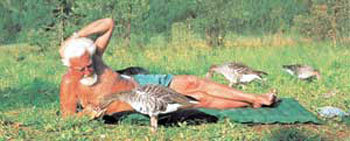The Goose Took Me as Its Mother
The Goose Took Me as Its Mother
Posted January. 16, 2004 23:33,

- Das Jahr der Graugans (A year with wild goose)
- Written by Konrad Lorenz
- Translated by Yoo Young-mee
Dr. Konrad Lorenz (1903∼1989), a world famous Austrian scientist in human and animal behavior, had stressed raising animals with a leave it alone attitude. He believed that we would be able to make more meaningful inquiries on nature only if we observed living animals in the most natural circumstances.
While raising higher-level animals such as rats, monkeys, ravens, and so on in the house by giving them indefinite freedom without locking them up in the cage, Dr. Lorenzs method had to sacrifice a lot in return. Dr. Lorenzs wife could not help but bring up her little babies inside a big cage in her home to protect them from the dangerous animals.
However, Dr. Lorenz was well rewarded. Seeing the animals that can leave me but not do it and stay with me is a great pleasure.(in his book King Solomons Ring)
The distinguished theories that Dr. Lorenz brought to the world were also, for the most part, thanks to unrestrained animals. In 1973, Dr. Lorenz was awarded the Nobel Prize in medicine and physiology for proving the so-called imprinting mechanism, which he discovered from a baby goose after just hatching from the egg which considered the first thing it saw as its mother.
In 1973, Dr. Lorenz led his research team to Alm Lake in Austria. They gave names to each goose and called them by names, cared for the young together, and anxiously waited for the young goose who left home. All the days that were spent with the wild geese for a year were vividly included in 147 pictures and writings.
● Season of spring, summer, love and conception
The wild geese in their mating years begin to do so from early spring. Dr. Lorenzs team discovered that there is homosexuality even between the wild male geese that are performing backplay (opposite of foreplay). Homosexual male couples are in higher status than heterosexual couples in the wild goose world because they are stronger and bigger.
Sometimes, unmarried female goose interrupts the homosexual couples. However, among male goose pairs, although one of the pair mates with female goose, it often does backplay with its male partner. For them, love is one thing and sex is another.
The wild goose shows a similar family life to humans. Combined with love, wild geese sincerely maintain their marriage for the rest of their life, if there is no exception, once they give birth.
● Autumn and winter, and lessons from the wild geese
Calendars are not needed in Alm Lake. It is autumn when the tall wild thistle blooms and the baby geese born that year are able to fly on their own. And then it becomes winter when the mountain suddenly is covered with snow one morning and leaves change to yellow and dewdrops hang on the spiders cobwebs. Around these days, wild geese bound about in great excitement. As a seasonal bird, they want to fly away to somewhere else.
At first, Dr. Lorenzs research team started to look into wild geese since its mode of life seemed similar to that of humans. Dr. Lorenz introduces his one-year living among the wild geese and suggests sympathy of the lives to his readers.
But it doesnt mean impersonation of the animal. Rather, Dr. Lorenz detests the fables of Aesop and La Fontaine. They tend to raise misunderstandings of animals in connection with ethics.
The animal has no concept on morality. Their behaviors come from their instinct, not from forecast of the results influencing their families and communities. Nature does not tell the right thing. ( ) What we can learn from the life of goose is the most basic thing. How to sleep, how to take rest
This book ends with the figure of goose deeply in sleep. German version published in 1985.
Jin-Yeong Lee ecolee@donga.com



![[속보]美 “미국인은 이란 당장 떠나라” 대사관 긴급 공지](https://dimg.donga.com/c/138/175/90/1/wps/NEWS/IMAGE/2026/01/13/133147285.1.jpg)



